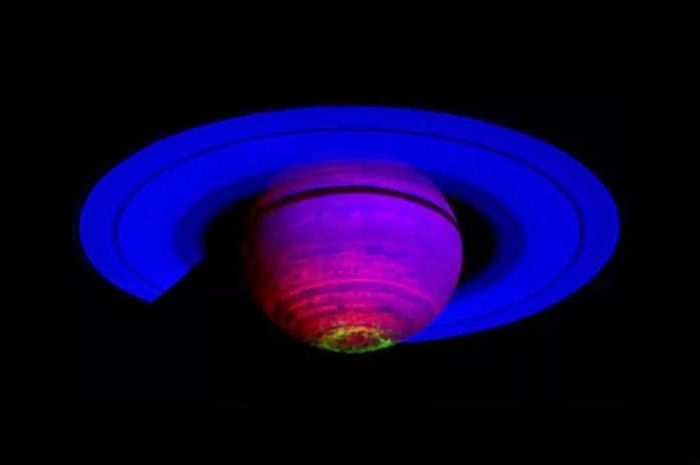NASA, Cassini, VIMS Team, University of Arizona, University of Leicester, JPL, ASI
–
Infrared image of Saturn showing the aurora at its south pole, photo captured by the Cassini Spacecraft.
–
Nationalgeographic.co.id—Leicester space scientists have discovered a never-before-seen mechanism that triggers aurora big planet in Saturn.
Just like on Earth, auroras also occur on other planets. On Saturn, the auroras seem very much different. Perhaps because the planet’s atmosphere is dominated by hydrogen, Saturn’s aurora displays can only be seen in ultraviolet light. Unfortunately, many questions about this aurora remain unanswered, even after the success scored by the Cassini spacecraft on its mission.
Saturn is unique among the planets observed to date in that some of its auroras are generated by winds swirling within its own atmosphere, and not just from the magnetosphere around the planet.
On all other observed planets, including Earth, auroras are formed only by strong currents flowing into the planet’s atmosphere from the surrounding magnetosphere. This is driven by interactions with charged particles from the Sun (as on Earth) or volcanic material erupting from the moons orbiting planets (as on Jupiter and Saturn).
This finding has changed scientists’ understanding of planetary auroras and answered one of the first mysteries raised by NASA’s Cassini probe, which reached Saturn in 2004: why can’t we easily measure the length of the day on the Ringed Planet?
When it first arrived at Saturn, Cassini tried to measure the mass rotation rate of the planet, which determines the length of its day, by tracking radio emission ‘pulses’ from Saturn’s atmosphere. Much to their surprise, they found that the pace appeared to have changed over the two decades since NASA’s Voyager 2 spacecraft last flew past the planet in 1981.

Bader dkk
–
A selection of full views of the northern and southern aurora ovals obtained during the mission phase of Cassini’s Grand Finale. The images are sorted by observation time.
–
University of Leicester researcher named Nahid Chowdhurypublished the results of his research in the journal Geophysical Research Letters on December 28, 2021. The title, Saturn’s Weather‐Driven Aurorae Modulate Oscillations in the Magnetic Field and Radio Emissions. Apart from being an astronomer, he is a member of the Planetary Science Group in the School of Physics and Astronomy.
Chowdhury said, “Saturn’s internal rotation rate should be constant, but over the decades researchers have shown that many of the periodic properties associated with this planet – measurements we have used on other planets to understand the rate of internal rotation, such as radio emission – tend to change with time. What’s more, there are also independent periodic features seen in the northern and southern hemispheres that vary during the seasons on the planet.”
“It’s thrilling to be able to provide an answer to one of the longest-running questions in our field. It will likely initiate some rethinking of how the effects of local atmospheric weather on a planet impact the creation of auroras, not just in our own Solar System, but further afield as well.” This study is the first detection of a fundamental mover, located in the planet’s upper atmosphere, which then produces the observed planetary periodicity and auroras,” he added.
PROMOTED CONTENT
Featured Videos
–


